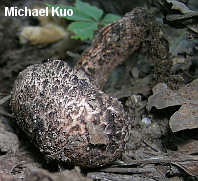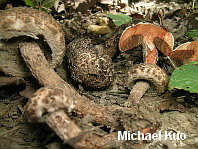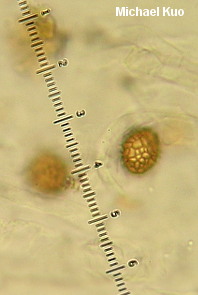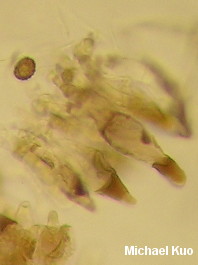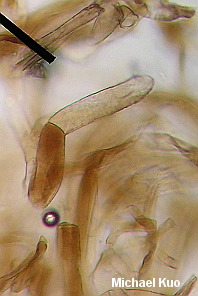| Major Groups > Boletes > Strobilomyces > Strobilomyces species 01 |

|
Strobilomyces species 01: "dryophilus" [ Basidiomycota > Boletales > Boletaceae > Strobilomyces . . . ] by Michael Kuo This putative species of Strobilomyces was first described in Nancy Smith Weber's Field Guide to Southern Mushrooms (Weber & Smith, 1985). Describing collections from Mississippi, Weber distinguished "Strobilomyces dryophilus" from Strobilomyces floccopus on the basis of its frequently pinkish young cap, which is "fibrillose to woolly" and only develops floccopus-like scales as it matures. Weber also thought that the spores of Strobilomyces floccopus had a "consistently less perfect reticulum" (whatever that means). Specimens that appear to match Weber's concept show up consistently in Douglas County, Illinois; they are illustrated here. Unfortunately Weber did not ever publish the species validly, by designating a type collection and providing an official diagnosis for the species, so the name is provisional. But the morphological differences she described have been noticed by other collectors, and the name "Strobilomyces dryophilus" appears fairly often in field guides and online (although several online photographs of the species clearly represent Boletellus ananas, instead). Description: Ecology: Mycorrhizal with oaks; growing alone, scattered, or gregariously; summer and fall, or over winter along the Gulf Coast; fairly widely distributed east of the Great Plains but more common from Texas to Florida, and possibly absent in the northern Midwest and in the northeast. Cap: 3-10 cm; convex becoming broadly convex in age; dry; when young hairy to woolly, becoming more scaly with age; scales wide, low, and soft; at first whitish to pale brownish or gray, with pink shades, especially near the margin; later with pinkish tan to tan, brown, or dark gray scales over a whitish ground; the margin frequently with hanging remnants of a whitish to grayish partial veil. Pore Surface: Whitish, becoming gray to black; bruising red, then black; pores angular, about 1 per mm; tubes to 2 cm deep. Stem: 4-8 cm long; 1-2 cm thick; more or less equal; whitish to pinkish or grayish; shaggy; sometimes reticulate near the apex; often with an ephemeral ring or ring zone; solid. Flesh: Whitish throughout, turning pinkish to red when exposed, then blackening over the course of an hour. Odor and Taste: Not distinctive. Spore Print: Blackish brown to black. Microscopic Features: Spores 9.5-12 x 7.5-9 µ (including ornamentation); subglobose to broadly ellipsoid; with ornamentation of ridges and lines forming a complete reticulum. Hymenial cystidia abundant; fusoid-ventricose; thin-walled; hyaline with brown mucros, or hyaline with large brown pigment globules, or rarely hyaline overall; to 50 x 12.5 µ. Pileipellis a cutis of frequently septate elements 5-17.5 µ wide; brown in KOH; terminal cells cylindric with rounded apices. REFERENCES: Cibula & Weber, invalidly published in Weber & Smith, 1985. (Weber & Smith, 1985; Both, 1993; Bessette, Roody & Bessette, 2000.) Herb. Kuo 09020501. This site contains no information about the edibility or toxicity of mushrooms. |
© MushroomExpert.Com |
|
Cite this page as: Kuo, M. (2013, December). Strobilomyces species 01: "dryophilus." Retrieved from the MushroomExpert.Com Web site: http://www.mushroomexpert.com/strobilomyces_sp_01.html |
